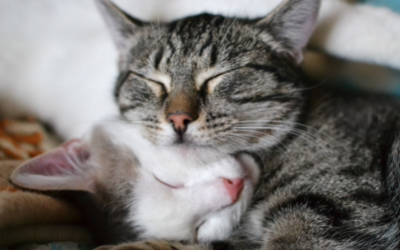
It’s kitten season once again, meaning shelters are starting to fill up with cats and kittens in need of a forever home. June marks “Adopt-A-Shelter-Cat Month,” an awareness campaign to help reduce the burden of cats and kittens that find their way into shelters during the month of June.
If you’ve been thinking about adopting a cat (or two), June is the perfect time to do it! If adoption is not in your cards, though, there are other ways you can help. Hosting a fundraiser with proceeds to a local shelter (or rescue) to honor your love of cats is one way to help, while making a gift of food or money to a shelter (or rescue) is another. If adoption is not something you are ready for, giving the gift of “space” to foster a cat or two is yet another way you can help. Finally, spreading the word about Adopt-A-Shelter-Cat Month on social media may inspire someone in your social circle to adopt!
While kittens certainly are appealing, adult cats need homes too. Senior cats, bonded pairs, and black cats are often overlooked. Consider adopting these. They are truly needy of good homes.
Adult cats, unlike kittens, are generally litter-trained, are often spayed or neutered, have been socialized, and have already learned the “rules of the house.”
Cats are often stereotyped as solitary and anti-social. This couldn’t be further from the truth! Cats generally prefer company over isolation. Strong bonds often form between littermates and cats that come together by chance. Adult pairs of cats are often separated because fewer people are willing to adopt an adult, let alone a pair of adults. Consider adopting a bonded pair to prevent them from becoming separated – separation often results in behavior changes, depression and illness.
Black cats are sometimes considered “boring” because they seem to look like one another – adopters are often looking for a unique-looking cat. Superstitions about black cats are not as common as they once were thanks to science, but some people, even today, still fear black cats.
Before taking the plunge, consider the following:
Budget. Consider the costs of caring for a cat, including food, litter, treats, toys, veterinary visits (at least yearly), preventive health care (vaccinations, parasite control, etc.). Be sure you are financially able to care for a cat (or two) for its entire life.
Time. Consider the time to properly care for a cat. Despite the stereotypes, cats prefer companionship. If you travel a lot or work long days, who will take care of your cat? Cats need daily grooming (brushing or combing the coat), teeth brushing, scooping of the litter, and exercise.
Let the cat(s) choose you! Meet several cats and find the one whose personality matches yours. Cats will often pick their owners, but if you’re not sure, an adoption counselor will be happy to help you find your perfect match.
Cat-proof your home. The items to check for that are tempting – to cats and kittens alike – include string, twist ties, ribbon, paperclips, sewing supplies, rubber bands, erasers, and hair ties. Keep your toilet lids closed, remove plants that are toxic (such as lilies, azaleas, begonias, and cyclamens – and if you’re unsure if a plant is toxic or not, remove it to be safe), secure cabinets (as some cats are quite adept at opening cupboards!), and lock the window screens to avoid escape.
This June consider supporting Adopt-A-Cat Month by adopting a cat or donating to a shelter or rescue.